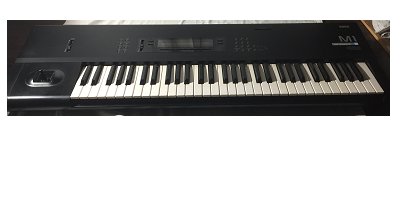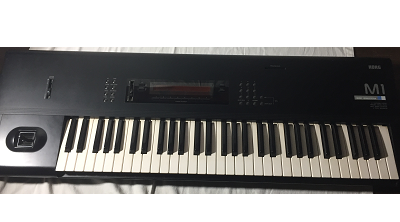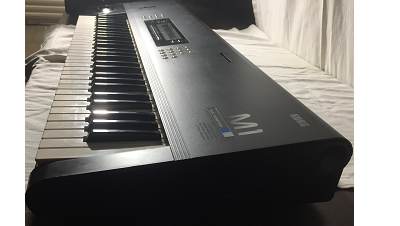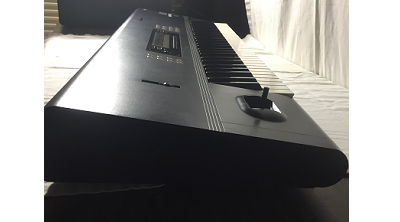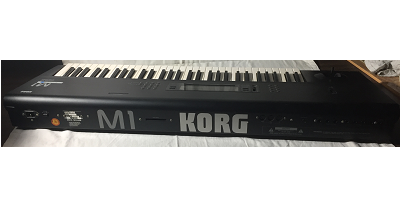Korg 61-key Digital Synthesizer Keyboard Workstation
$1,469.00
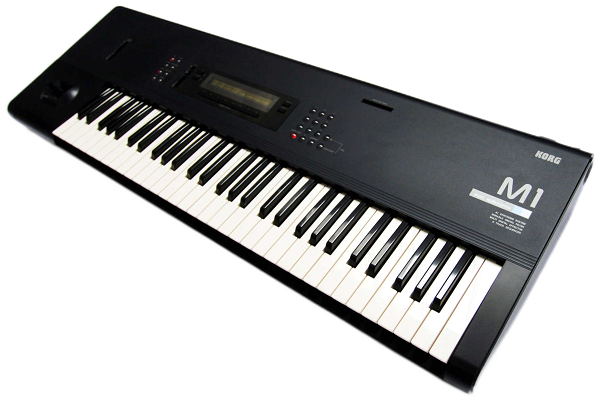
Model# M1
16-note polyphony keyboard sensitive to velocity and after touch, MIDI compatibility and on-board effects. Several preset sounds that are relatively novel acoustic instruments to exotic instruments and slow-attack ambient patches. With its broad palette of sounds and effects this is an iconic part of pop culture.
💀 A Blond Melon Favorite
A 16 voice, 8 part multi-timbral, music workstation, featuring a MIDI sequencer and a wide palette of available sounds, which allowed for the production of complete musical arrangements. comes with M1 Music Workstation cards (MPCOOP) and voice sound library cards also included are all manuals and the power cord. The cards are over a $350.00 value.
The workstation is capable of creating acoustic instruments with clarity, nice digital sounds and good buzzy techno sounds. In addition to its acclaimed sound, it has a somewhat sophisticated 8-track sequencer. It holds 10 songs and 100 patterns and up to 7,700 notes, and offers full quantizing and editing. Full MIDI implementation suites the M1 ideally for studio production and MIDI system use. Up to 8 parts of multi timbrality with the 8 track sequencer makes for a powerful machine. Add to that a host of digital multi-effects and you've got one of the most widely and professionally used synthesizers around.
This is an eight-part multi-timbral synth, with sample PCM based sounds, drums onboard and an eight-track sequencer, you really can produce some serious music on a single machine, from start to finish.
An amazing set of stylized sounds that are nicely categorized into instruments patches from number 00 to 99. Sound 00 was entitled Universe; its pad-like digital construct transported you to another dimension, while the ubiquitous Pan Flute and Fretless Bass offered that late 80s date stamp with true aplomb.
Also offering a serious smattering of hefty drum sounds, accessible via the five-octave touch-sensitive keyboard. These are fairly usable, but using the drum map from the Roland Pad-80, allowing for a quick round of the coolest sounding drum set.
The M1 started something of a trend, with the full application of multi-effects to the construction of certain sounds. These could be liberally applied to just about anything you wished to hear, and layered they were, in copious amounts, reflecting the true 80s trend for big snares, with even bigger reverbs. It was firmly a digital reverb, and not what might be regarded as the finest example of such, especially when layered across entire swathes of drums and percussion.
But fear not, you could remove the effects and get on with the key-hole surgery of sequencing an entire song, via the two-line LCD display. Tedious and time consuming are two words that might be suitable for the description of this process, but it was all onboard, and you made do, because the end result was worth it.
Once you’d sequenced up your eight tracks of basses, drums, leads et al, you could sit back in wonder, even allowing for the sequencer to trigger external devices, and hear your time-consuming work in all its glory, but use your notes wisely, because you may well have used up the 7,700 note sequencing limit, meaning that you’d have to delete one of the ten saved songs (note limit allowing!) in order to get on with the next. Never has the ‘are you sure you want to delete this song?’ dialogue struck such disappointment into the hearts of musicians. It is an amazing machine with brilliant sounds that swallowed up more of my time than I care to consider.
Features:
Individual M1 programs can use one or two oscillators. The former is required if you want to trigger 16 notes at a time, although Korg's effective implementation of dynamic voice allocation, which will quickly reassign silent oscillators as needed, can often compensate for taxing polyphony requirements. Single‑oscillator sounds generally aren't too thin‑sounding either, thanks to the M1's complex sampled waveforms and onboard chorus and reverb effects.
You can adjust the volume balance of the two oscillators in a double program, and detune the second oscillator using interval and fine‑tune parameters. In addition, the attack of the second oscillator can be delayed by up to five seconds, for further complexity.
Each oscillator is paired with its own digital low‑pass filter and filter envelope. The filters aren't resonant, and sweeping their cutoff won't sound as smooth as it would with analogue filters. However, those aren't major irritations, as the sound set is harmonically rich enough to offset the lack of resonance, and the effects can mask any swept‑filter graininess.
Separate LFOs are provided for vibrato and filter modulation, and in a double‑oscillator voice you can assign each LFO to modulate either or both voice channels. It's also possible to program each LFO's rate to be modulated independently by joystick movements.
The engineers didn't settle for simple ADSR envelopes. Along with the usual attack, decay, sustain, and release rates and levels, the filter and amplitude EGs include parameters for attack level, break point, slope time, and release level. Added to the pitch EG's envelope parameters are start and release levels; there's no sustain‑level parameter because the key's basic pitch determines that level. All three EGs can be programmed to respond to key velocities by varying the overall envelope level and time. In addition, the filter and amplifier EGs can be set to track to key position for different types of response.
Built‑In Effects:
When you dig into the M1's effects section, you'll find a considerable amount of power — especially considering that the concept of putting multi‑effects processors inside a synthesizer was a very fresh one at the time of the synth's creation. Among the effects algorithms are reverbs, early reflections, stereo delays, chorus and flange, tremolo, two‑band shelving EQ, distortion, an exciter, a Leslie simulation, and numerous multi‑effects combinations. Both series and parallel signal‑routing configurations are available for the two processors.
Since the M1 has only the two effects processors, all of the Programs assigned to a Combi can't have access to the same effects they used in Program mode — a shortcoming which dogged early workstation synths from more than one manufacturer. However, routines are provided for copying effects parameters from one Program or Combi to another, and there are specialized Combi effects in which each processor runs two effects algorithms simultaneously, such as delay and reverb. If a dual‑algorithm Combi effect is assigned to each of the two processors, you could construct a four‑Program Combi in which each Program has access to its own effect. Usefully, any program in a Combi can be set to bypass the effects entirely.
Anyone who's taken the time to properly mic an acoustic drum kit can surely appreciate the convenience of a synthesizer loaded with great drum sounds — and the M1 was the first. You can store four independent drum kits, each made from up to 30 different sounds assigned to specific MIDI note numbers. Since the M1 has four outputs, drum or percussion sounds may be assigned to specific outputs for external processing.
Specifications:Used – Very Good
Type: Synth/ Workstation/ keyboard/
Synthesis Type: Digital AI with 8? MB of ROM
Polyphony: Max: 16
Typical in use: 16 Multi-timbral (number of parts): 8
Oscillators per Voice : Min : 1 - Max : 2
Controllers : joystick
Effects : Number of FX units : 2 ~ Number of different effects : 32
Drum Section : Number of Drum Kits : 4 ~ Number of Drum sounds : 200
Keyboard : Number of Keys : 61 ~ Can send on 1 simultaneous MIDI channels
Responds to : velocity, after-touch ~ Sounds can be split by : keyboard
Memory : Patches : 100 ~ Performances : 100
Number of Audio Outs : 4 (excluding Phones)
Number of Audio Ins : 1
Number of MIDI Outs : 1
Number of MIDI Ins : 1
Number of MIDI Thru : 1
Upgrade Options : PCM cards and RAM memory cards
Sequencer Memory : Number of Notes : 10000 ~ Number of Patterns : 8
Number of songs : 10 - Depends on memory use
Same Day Shipping - Ships from Blonds personal stash
Located in: New Orleans, Louisiana, United States
Handling Cost:
$20.00 will be added on items over 30lb
$50.00 will be added on items over 100lb
Free local pickup
Shipping: Calculate
make an offer
